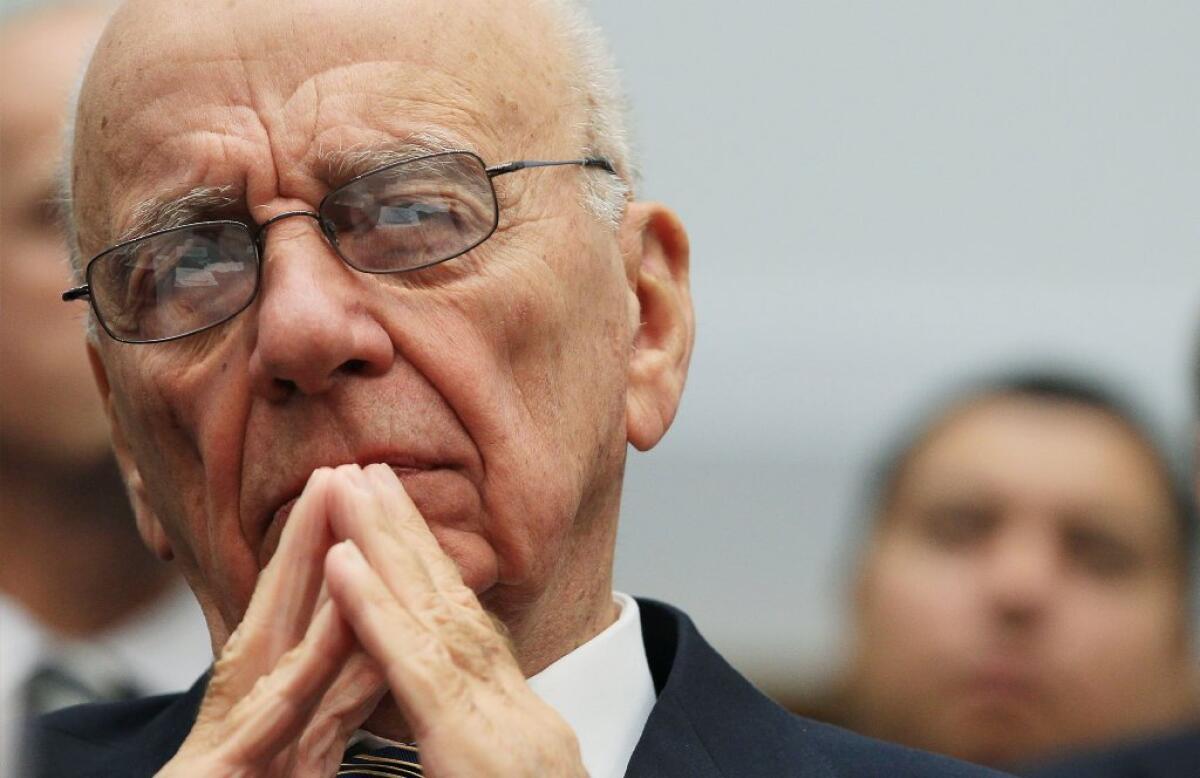News Corp. divides into two companies; 21st Century Fox is born

- Share via
Rupert Murdoch’s sprawling, $75-billion global empire has broken into two separate companies: 21st Century Fox and a much smaller News Corp.
Friday afternoon, just after the close of trading, the company finalized the transaction that had been in the works for more than a year. Beginning Monday, shares of the two companies, both controlled by Murdoch and his family, will trade separately on the NASDAQ stock exchange.
The 82-year-old media baron has spent the last 60 years building an enormous empire from a single newspaper in his native Australia. Murdoch will serve as executive chairman of both News Corp. and 21st Century Fox. He also will be chief executive of Fox, the larger of the two entities.
“21st Century Fox launches as a unique force bringing news and entertainment to more than a billion customers every day in over 100 languages,” Murdoch said in a statement.
PHOTOS: Hollywood Backlot moments
21st Century Fox will boast assets that have generated three-quarters of the consolidated company’s revenue and nearly all of its profits: the 20th Century Fox movie and television studios, Fox News Channel, Fox Sports, FX, National Geographic and the Fox broadcast network.
“The split should help drive upside for 21st Century Fox,” RBC Capital Markets analyst David Bank said in a research note Friday.
The publishing group will take the name News Corp. It will include such newspapers as the Wall Street Journal, Times of London, New York Post, the Australian, the HarperCollins book publishing house, several Australian television properties and a nascent educational materials business called Amplify.
Monday’s trading will establish valuations for both companies and test whether investors share Murdoch’s confidence in the future of newspapers and books. Preliminary shares of the stocks have been trading since last week. Shares of the publishing entity traded at about $15 a share, giving that part of the empire a value of more than $8.5 billion.
The move also should reveal how much the Fox entertainment assets are worth as a stand-alone entity without experiencing the financial drag of Murdoch’s newspapers.
ON LOCATION: Where the cameras roll
Wall Street’s enthusiasm over the breakup has been building for more than a year, since word leaked that Murdoch would spin off the newspapers from the more lucrative film and TV assets.
News Corp. stock has soared more than 60% since the middle of June 2012, wiping out much of the discount that has long suppressed the value of the stock in Murdoch’s company. Other media companies, including Viacom, Comcast and the Walt Disney Co., historically have traded at higher levels.
News Corp. closed trading Friday at $32.58, down 11 cents a share.
People who owned News Corp. stock as of June 21 will receive shares in both companies. Every four shares of News Corp. stock will be exchanged for four shares of Fox and one share of the new News Corp.
As before, there are two classes of stock for both companies: Class A non-voting shares and the closely held Class B voting shares. Murdoch and his family will control 39% of both Fox and News Corp. through their holdings of Class B voting shares.
PHOTOS: Celebrities by The Times
Tickers for the Fox stock will be FOXA (for the Class A shares) and FOX (for the Class B shares).
The new News Corp. will assume the tickers of its parent: NWSA (for the Class A shares) and NWS (for the Class B shares).
Murdoch has said the new entity, which will bear the News Corp. name and boast 120 newspapers, will make up the largest publishing operation in the English-speaking world. It will spring to life with no debt and $2.6 billion in cash to fund operations, upgrade equipment and make acquisitions.
News Corp. executives expect its book publishing revenue to stabilize because profit margins are higher for electronic books than for hard copies. For its news and information properties, company managers last month outlined a strategy centered around growing subscription revenue, which they believe will offset declines in advertising revenue. The company also plans to experiment with different online windows of availability for news content.
Some of Murdoch’s weaker newspapers might be forced to scale back. Some of the publications have relied on News Corp.’s deep pockets and free-flowing profits from the television division to prop them up amid sliding circulation and advertising revenue.
“We will be relentless in our cost-cutting and in our pursuit of profits,” Robert Thomson, former managing editor of the Wall Street Journal and incoming chief executive of the reconstituted News Corp., said late last month during a day of presentations to investors. “But we will also be a resolutely creative company — creativity will not be the preserve of the few but the mission of the many.”
Earlier this month, several of Murdoch’s publications, including the Wall Street Journal, which remains profitable, and two money-losing newspapers, the New York Post and the Times of London, began shedding staff. The Wall Street Journal is expected to lose a handful of editorial employees, and the company plans to hire more reporters to cover such beats as technology and central banking.
ALSO:
Rupert Murdoch awaits California liquor license
News Corp. reviews costs; Wall Street Journal offers buy-outs
News Corp. Chief Rupert Murdoch files for divorce from his third wife
Comcast CEO Brian Roberts invited to join Academy of Motion Picture Arts and Sciences
More to Read
From the Oscars to the Emmys.
Get the Envelope newsletter for exclusive awards season coverage, behind-the-scenes stories from the Envelope podcast and columnist Glenn Whipp’s must-read analysis.
You may occasionally receive promotional content from the Los Angeles Times.







